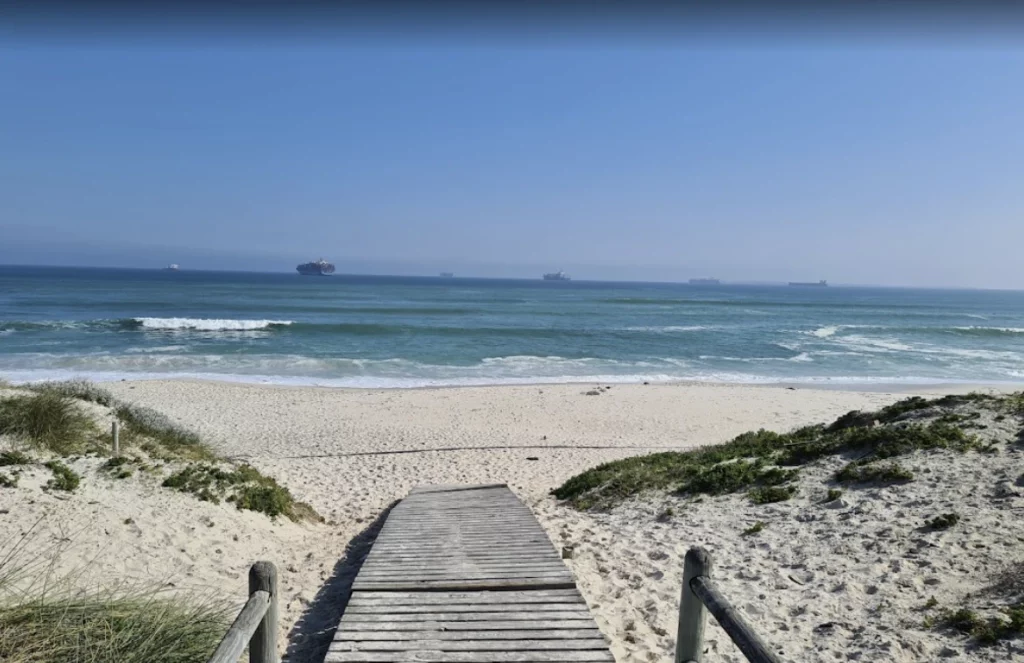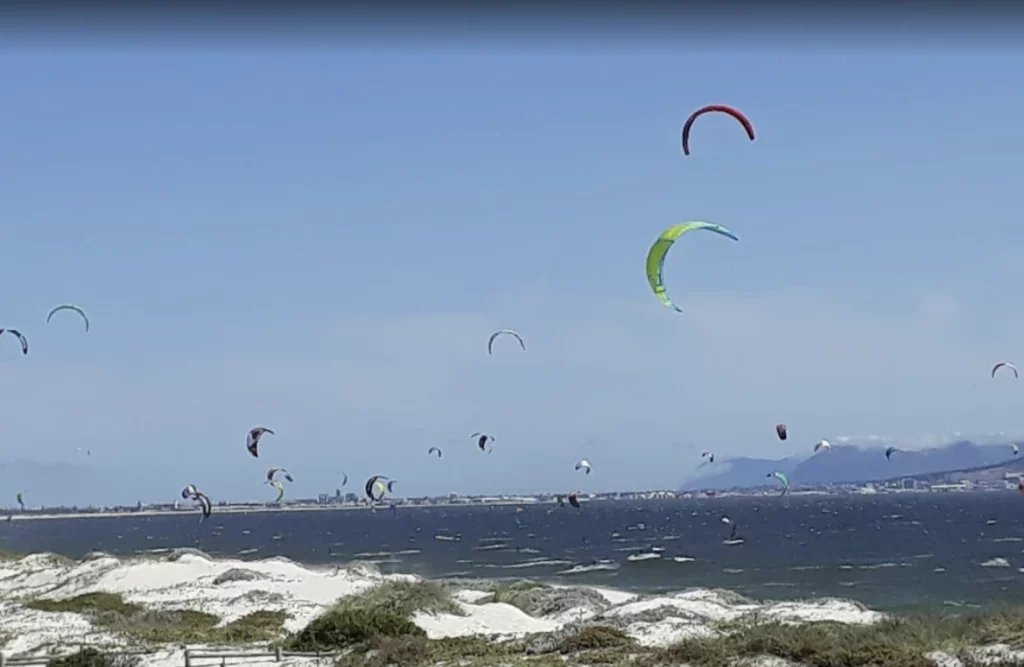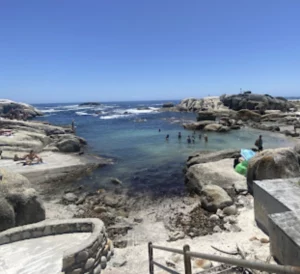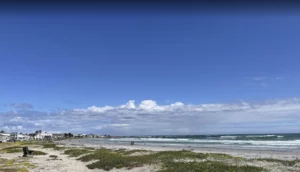Bloubergstrand Beach is a bay of Table Bay, Cape Town, South Africa. It is located in the suburb of Bloubergstrand, about 7 kilometers north of Cape Town city centre and just south of Sugarloaf mountain. The beach itself is protected by an outlying rock shelf from the open sea but it faces north-west, so gets good sunshine all year round.
Bloubergstrand beach is located in a sparsely inhabited, undeveloped area
Bloubergstrand beach is located in a sparsely inhabited, undeveloped area over the Great South Bay from Cape Town’s city center. It is only accessible by car or taxi, but the drive is worth it once you get there. This sandy stretch of coast has no facilities—not even toilets!—but that doesn’t stop locals from enjoying this beach.
The beach has a very long stretch of white sand that is perfect for sunbathing, swimming and surfing. The water is crystal clear and the waves are gentle enough that they won’t knock you over. There are no lifeguards or other facilities at this beach but there are parking lots nearby.
FAQ
Q: What is the best time to visit Bloubergstrand Beach?
A: If you are looking for a beach holiday in Cape Town, Bloubergstrand is a great option. There are two seasons that you can visit this area: summer and winter. June is the hottest month with an average maximum temperature of 28ºC/82.4ºF while January is coldest with an average minimum temperature of 14ºC/57.2ºF. The average rainfall level during summer months is 1078 mm/42 inches while it drops to 886 mm/35 inches during winter months.
If you want to enjoy clear blue skies and sun all day long, then summer months would be perfect for your trip but if you prefer exploring nature with lots of greenery around then winter months might be ideal for you as well!
Pros & Cons of Bloubergstrand Beach
The pros and cons of Bloubergstrand Beach:
Pros:
- It is a beautiful beach with a great view of Table Mountain, which can be enjoyed from the comfort of your own towel.
- There are also plenty of restaurants nearby, so if you’re not in the mood to cook yourself, there’s no need to go far.
Cons:
- This beach is popular and can get very crowded on weekends when Capetonians come out in droves to relax by the water.
- The waves are also strong at times, so swimming might not be for everyone.
“Bloubergstrand Beach is located in Cape Town’s Blouberg suburb. It is protected by an outlying rock shelf and faces north-west so gets good sunshine all year round. The sand is soft, the water is clear, and this beach has been proclaimed as one of the 10 most beautiful beaches in the world by Beach Advisor.”
— Rostislav Sikora, Author

Bloubergstrand Beach during hot season
The best time to visit Bloubergstrand Beach is during the winter months, which usually run from May to September. The summer months are generally hotter and it experiences less rainfall than other parts of Cape Town.
The weather in Bloubergstrand Beach is affected by the warm Benguela Current that flows along Africa’s west coast. This can mean that even when it is cooler outside, the sea breeze coming off Table Mountain means that temperatures at beach level remain quite high, especially on days when there is little wind blowing through the valley between Table Mountain and Signal Hill, close to Bakoven beach
A broad sand spit extends out of the bay and is gradually eroded by the waves.
On the morning of your visit, you will arrive at Bloubergstrand beach in a sparsely inhabited, undeveloped area over the Great South Bay from Cape Town’s city center.
You’ll notice that there are no restaurants or other amenities nearby; this is part of its charm. After exploring Bloubergstrand beach (the sand spit extends out into the bay and is gradually eroded by waves), you can head back to Cape Town to see more sights in town or spend some time on Signal Hill or Table Mountain or visit Melkbosstrand Beach.
If you’re looking for more of a beach experience, head to Muizenberg Beach. This popular, family-friendly spot is just a short drive from Cape Town’s city center and offers opportunities for swimming, snorkeling and surfing. More ifno you can get on Google review.

The beach is named for the Blouberg Mountains, to the north.
The mountains have been an important landmark for centuries as a guide to sailors navigating around Cape Town’s coastline. Today, the mountains are home to many different species of birds and other animals, including baboons and leopards. The mountain range was named by Dutch explorers in 1503 after Jan van Riebeeck’s expedition ship “De Aarde” (The Earth).
The beach itself is located in a sparsely inhabited, undeveloped area over the great south bay from Cape Town’s city center—in fact, it can take up to two hours to get there by car. People often drive out here just because they want somewhere quiet and peaceful; you’ll find almost no development at this end of Table Bay except for Bloubergstrand Beach Park with its open-air restaurant serving traditional South African cuisine and stunning views across Table Bay towards Robben Island where Nelson Mandela was imprisoned for 18 years before being released into much freedom in 1990 (see our Nelson Mandela tour).
The long-term trend in sea levels at Cape Town has been a lowering of the land level, which means that the town has been steadily moving inland. This is due to the fact that the land is sinking at a rate of about 2mm per year.
The reason for this is not fully understood, but it may be due to the fact that the land in and around Cape Town is composed of a soft sedimentary rock called argillite. This type of rock can be easily dissolved away by groundwater percolating through it. As this happens, the land surface sinks down into the porous layer below.
In the beginning of the 20th century, several cities were established along both sides of Table Bay.
Some of these cities include: Cape Town (1652), Simon’s Town (1780), Stellenbosch (1679), Paarl (1687) and Somerset West (1799).
The first European settlers arrived in the Cape in 1652, when Jan van Riebeeck and his crew set up a refreshment station for ships traveling between Europe and Asia. The first permanent settlement was established on Table Bay by the Dutch East India Company in 1652 at what is today Cape Town. They were joined by the French, who founded their settlement at Port de France (now known as Franschhoek). The British took over the Cape of Good Hope area in 1795 during the Napoleonic Wars, but returned it to the Dutch East India Company in 1803.
Between 20 and 40 years after these cities were founded, their populations had grown to as many as 100 000 people each.
Cape Town is one of the most populous cities in South Africa, and it’s also one of the most crowded. With a population of 3.7 million people, it has a population density of over 2200 people per square kilometer. This makes it one of the most densely populated cities in the world—and if you’re planning on visiting Cape Town with your family or friends anytime soon, here are some things you need to know about how large this city really is:
Today there are still many houses along this stretch of coast because they are close to the beaches and most people do not own cars and therefore can commute easily.
Bloubergstrand is one of the oldest suburbs in Cape Town and today houses many people who live on this stretch of coast because they are close to the beaches, they don’t own cars and therefore can commute easily. Today there are still many houses along this stretch of coast because they are close to the beaches and most people do not own cars and therefore can commute easily.
The city covers an area of just over 400 square kilometers, which makes it larger than the cities of New Orleans and San Francisco. – Cape Town has a population of 3.7 million people, making it one of the most densely populated cities in the worldThe area is very popular with people who enjoy the outdoors and there are many hiking trails in the hills behind it. The houses on this stretch of coast that were built before 1990s are all single level and are therefore very affordable. Many people who live here do not own cars because they don’t need them as there is a bus stop just outside their front door.
What other says about it
If you want to know what others say about Bloubergstrand Beach, here’s what some of them have said:
- “Bloubergstrand beach is one of the best places for kitesurfing in Cape Town.”
- “Bloubergstrand beach is a popular spot for surfing.”
- “Bloubergstrand beach was ranked as South Africa’s number one beach by TripAdvisor users.”
- “I love going there because it feels like I am walking on water when I’m in the water. The waves are clean and clear and make me feel like I’m swimming through heaven!”
“I love going to Bloubergstrand Beach because it is one of the most beautiful beaches in Cape Town. It’s also a great place for surfing and kitesurfing.”
Kite surfing at Bloubergstrand Beach

Kite surfing is a sport that requires skill and experience, but once you get the hang of it, it’s an exhilarating experience. Kite surfing is also a good way to get exercise while having fun on the beach. However, kite surfing can be dangerous if you’re not careful. You should always wear safety gear such as a helmet and gloves when learning how to kite surf because there are many hazards in the water that could cause injury or death: sharks, jellyfish, riptides (strong currents), rocks jutting out of the sea floor (reefs), etc.
You should also know how to swim, as kite surfing is a sport that requires swimming. If you don’t know how to swim, it’s recommended that you take lessons before trying out kite surfing.
Conclusion
The Kite surfing, one of the most popular water sports in Cape Town and Bloubergstrand beach is one of the best place to practice this activity. The wind at Bloubergstrand beach blows very consistently all year round, making it an ideal location for kite surfers and windsurfers alike. With its beautiful scenery and great waves, this part of Cape Town is a must-do when visiting South Africa!







Leave a Reply